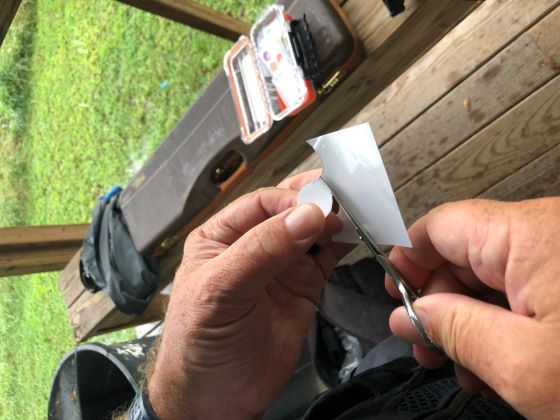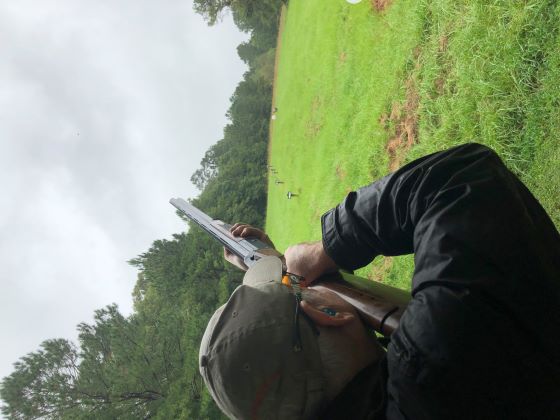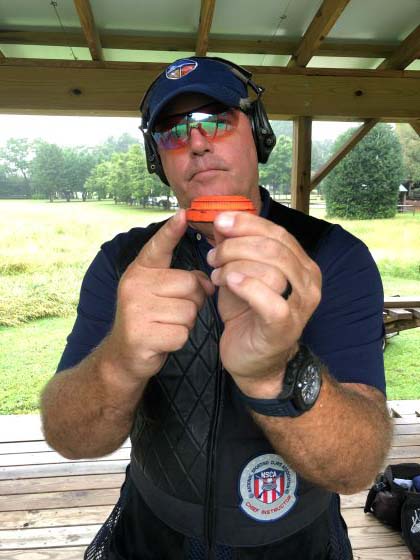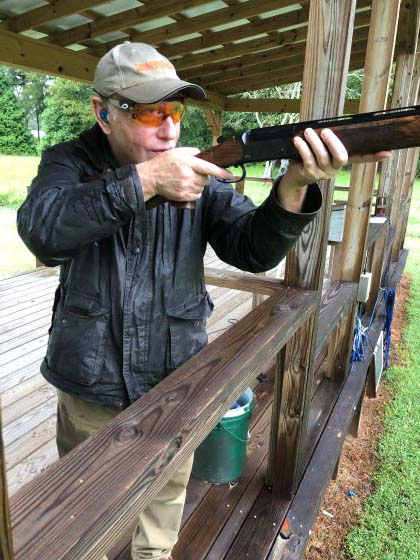How Don Currie Fixed my Sporting Clays Game

I wouldn’t exactly call it a slump, but clearly my sporting clays performance felt like it was undergoing a creeping atrophy of body and mind. Focus and concentration required digging deeper and deeper into myself, casting adrift my inner instinctive shot like an untethered astronaut floating off into space. Finally, I simply had to accept the inevitable: go ahead and just take lessons again.
After all, plenty of experienced clays shooters take lessons, including myself. But what I discovered over the years is that some instructors actually made my game worse, while others certainly contributed to a lasting improvement. Eventually, I developed an attitude about clay-shooting lessons that went something like “better the devil you know than the devil you don’t know.” In short, I’m okay with shooting okay rather than risk having an instructor completely ruin my game.
Except that I found myself regularly missing targets by shooting over them. Was I leaning back? Was the comb on the stock adjusted wrong? Was I not putting the shotgun firmly to my face? Should I have been shooting pre-mounted instead of low gun? I could not for the life of me figure out the problem.
 Don Currie at the Burge Club in his mobile office. He had the Perazzi over his shoulder because he sells them, often accompanied by a custom gun fit.
Don Currie at the Burge Club in his mobile office. He had the Perazzi over his shoulder because he sells them, often accompanied by a custom gun fit.And that’s when I decided to call Don Currie.
He’s the chief instructor of the National Sporting Clays Association and one of the most sought-after shooting coaches and gunfitters in our sport. He’s the guy who oversees certification of all NSCA instructors. His instructional DVD “Focus – Movement – Faith” is the number-one rated sporting clays DVD on Amazon. Don’s book “Mastering Sporting Clays” is a best-seller in the category. And he has a new book coming titled “Gunfitting: Achieving the Ideal Fit for the Game and Clay Shot.” In fact, it’s his skill as a gunfitter that caught the attention of James Purdey & Sons who recruited him to consult on their ground-breaking Trigger Plate Sporting Clays Shotgun.
 Don Currie’s latest book, “Gunfitting: Achieving the Ideal Fit for the Game and Clay Shot.”
Don Currie’s latest book, “Gunfitting: Achieving the Ideal Fit for the Game and Clay Shot.”Don agreed to meet me at The Burge Club, a private historic 1,000-acre farm in eastern Newton County, Georgia with a wooded sporting clays course boasting between two and five throwing machines on each station, as well as two covered five-stands that served us well on that rainy afternoon. The Burge Club dates back to 1809 as a farm that has remained in the Morehouse family through the Civil War, Reconstruction, the Great Depression and two world wars. In the 1980s and 1990s, Burge was expanded to include cabins located around the farm, as well as a covered pavilion, a lodge, and the Conservatory, a banquet and event facility.
 The Burge’s clubhouse.
The Burge’s clubhouse.The three-hour drive to Burge in a torrential downpour provided enough time to determine exactly what I wanted from the day’s lesson. Of course, we all want to shoot better, but I wasn’t meeting with Don for a tactical fix. My issues were broader than the difficulty one might have on a single type of presentation, like a crossing target. My objective had to concentrate on the long-term, breaking out of my plateau and evolving as a sporting clays shooter and bird hunter. I realized that what I wanted from Don was to improve my consistency, because it’s through consistency that you emerge on the other side as a better developed, confident shooter on the path to self-sustaining success.
Despite the rain, Don’s hospitality was warm-hearted. He met me at the club’s hard-to-find entrance gate in his SUV, so I could follow him along a warren of roads to the clubhouse. Once in the parking lot we shared a friendly handshake.
Don starts his lessons with the NSCA’s four recommended steps: eye dominance assessment, gun fit check, interview to determine your shooting experience and goals and finally a safety briefing before we handle the shotgun.
His instructional style is comforting, helpful and knowledgeable – almost like a doctor.
Don began with an eye-dominance test. As a right-handed, left-eye-dominant shooter I’ve been wearing a round translucent patch on my left lens for years now. After watching me take a few shots, and establishing a base line for my eye dominance, he determined that, despite the patch on the left lens of my shooting glasses, my left eye was still taking over during shots.
The first thing he did, though, was change my lens color from purple to yellow.
“You want to let in as much light as possible,” he told me. “The more light you let in, the better you can see the target.”
 Don Currie cutting a new eye patch for the author’s shooting glasses.
Don Currie cutting a new eye patch for the author’s shooting glasses.Using cuticle scissors and a sheet of film from his patch kit, Don created a smaller dot that he applied to the yellow lens, in a slightly different position than was the larger patch I had arrived with. It was a process. He started with a lighter opacity, increasing the density after I shot a few targets, until he was satisfied. Improved results with the final dot were instantaneous, especially on left-to-right crossers.
As it turns out, we saw that the new dot also helped reduce my chronic problem of shooting too high. The original patch was forcing me to slightly lift my face from the stock for a clear view of the target – certainly one of the most prevalent reasons for shooting over targets.
Next, he concentrated on gun mount and fit. Despite my lingering fears, the adjustable comb on my stock was fine. Gun mount, however, not so much.
In my default ready position, the heel of the gun’s butt pad had been located a few inches under my arm pit. He suggested moving the gun out a bit, so that the heel was slightly in front of the armpit, thus enabling me to move the gun straight up to my cheek without having to move the gun forward to circumvent the front of my arm pit. Again, I saw another improvement in the number of busted clays.
 The author taking a high pair of targets at the Burge Club’s five-stand.
The author taking a high pair of targets at the Burge Club’s five-stand.After shooting a number of targets on the five-stand, we were about 30 minutes into the lesson – a point when he usually takes his students onto the sporting clays course to evaluate their technique on a wider variety of targets. By now, the rain had subsided. We jumped in the golf cart and, while driving on the wooded trails, he described the seven target tactics that he teaches his students and uses in his own shooting. He thinks of them as decidedly effective tools that yield high levels of performance on different target presentations.
1. “Touch and Separate” (or Pullaway) is recommended for crossing targets with a flat trajectory. Hold two-thirds back from the breakpoint toward the trap, making sure the target never gets in front of your barrel. As the target emerges from trap, merge with/insert the muzzle on the nose of the target, separate from the target (accelerate away from the target along target line) and execute the shot decisively. Your focus must remain on the leading edge of the target all the way through the separation and shot.
2. “Maintained Lead” (or “Sustained Lead”) can also be used for crossing targets with a flat trajectory at the breakpoint. Don explained that some shooters are more comfortable with Maintained Lead and others with Pullaway on these types of targets. Still other shooters may use Maintained lead on closer slower crossers and Pullaway on faster longer distance targets. As with Pullaway, the bird should never pass the muzzle of the gun. Establish your hold point two-thirds back from the breakpoint toward the trap. As the target appears, move and mount the gun inserting the gun to the lead, and matching the speed of the target as you execute the shot.
 Don Currie discussing target break points.
Don Currie discussing target break points.2. “Cut-off/Collapse” (or “Intercept”) is best suited for targets that are transitioning or descending at the breakpoint. In general, establish a hold point that is offset from the target line and halve the distance between a holdpoint and breakpoint that you would normally use for a flat trajectory target. It addresses the most common cause of a miss on a target that is transitioning at the breakpoint: excess gun movement that follows the target line. Moving your hold point closer to your breakpoint, and initiating your move early, will ensure that you arrive at the breakpoint before the target, which is essential for this type of target.
3. “Quartering Move” is best for flat-trajectory quartering targets flying at about 45 degrees from the shooter. Establish a hold point that is one-third back from the breakpoint toward the trap machine, let the target come to the muzzle, then aggressively move the gun muzzle to the leading/inside edge of the target.
“Cutoff/Collapse,” Quartering Move, Maintained Lead and Pullaway address about 80-to-90 percent of target presentations on a typical 100-target sporting clays course. He refers to the other moves as “specialty moves,” but stresses that they are of equal importance to master.
5. “Diminishing Lead” works on outgoing-overhead targets (e.g., outgoing tower targets) and edge-on rabbits. Establish a hold point that is immediately under the breakpoint (for overhead targets), or otherwise on the line at the breakpoint (like the edge-on rabbit). Commitment to your breakpoint is essential. You will be sacrificing flow (synchronization) in order to maintain good visual connection with the target through the breakpoint.
 Don Currie explaining gun mount to the author.
Don Currie explaining gun mount to the author.6. “Two-piece” (or “Pass-through”) gets its name because you must pass through and occlude the target to break it. One example is the outbound fast-moving teal targets that reach an apex at or beyond a range of 50 yards from the shooter, and must be engaged under power and on-the-way-up. Plan your breakpoint at a spot where the target is still under power. Establish your hold point about one-third of the way back toward the trap from the planned breakpoint. Let the target rise from under the gun and appear above the muzzle, then immediately move through the target, from “butt-to-beak” and execute the shot.
7. “The Rabbit Move” (“Let it beat you, stab it with a fork”) is advised for crossing and quartering rabbits. This technique is similar to the quartering move except that you must allow the target to pass your gun muzzle, not just come to the gun, before making your move to the target. It is often helpful to have the gun moving toward the breakpoint at a very slow pace when the target passes the barrel. This “creeping” movement of the gun will smooth out your movement and make it less abrupt.
On the wooded sporting clays course, we stopped at the covered stations in the rain. Don fine-tuned my move and mount techniques, resulting in me breaking the targets faster, more consistently and more confidently.
 The author ready to shoot targets at the Burge Club five-stand.
The author ready to shoot targets at the Burge Club five-stand.For starters, he told me to slow down, reminding me that “Slow is smooth. Smooth is fast” Smooth allow the shooter to maintain acute visual focus on the target.
At the same time, his seven different target tactics helped me break the targets faster and in a more controlled manner. I realized that following Don’s advice to move the butt of the gun closer to the shoulder pocket cut my reaction time to the breakpoint and actually improved my focus. By remembering that “smooth is fast,” I realized that smooth also means improved target focus.
The biggest takeaways from me lesson were: 1) As a successful sporting clays shooter, you need more than just one engagement technique, 2) that I needed to evaluate each and every target and build my plan before stepping in to the stand, and 3) that the efficiency of my mount and move determined by ability to apply intense visual focus on the target. He also explained that, when it comes to flat trajectory crossing targets, I would be more successful employing the pull-away than maintained lead, which I proved to myself during our lesson.
In reflecting back to my lesson, I can honestly say that my objectives for scheduling a lesson with Don had all been met. With a better stance and more efficient mount and move, my visual focus and scores have improved and I’m no longer shooting over the top of targets. I also now understand that I must adapt my technique to the wide variety of targets I will encounter on the sporting clays course by employing the appropriate target tactic for the given target. When I miss, it’s either going to be sloppy technique or lack of focus. With more effort in developing and executing a well-thought-out plan, I am more confident and more successful when in the shooting stand.
Mission accomplished.
Irwin Greenstein is the publisher of Shotgun Life. You can reach him at contact@shotgunlife.com.
Useful resources:

Irwin Greenstein is Publisher of Shotgun Life. Please send your comments to letters@shotgunlife.com.


Comments